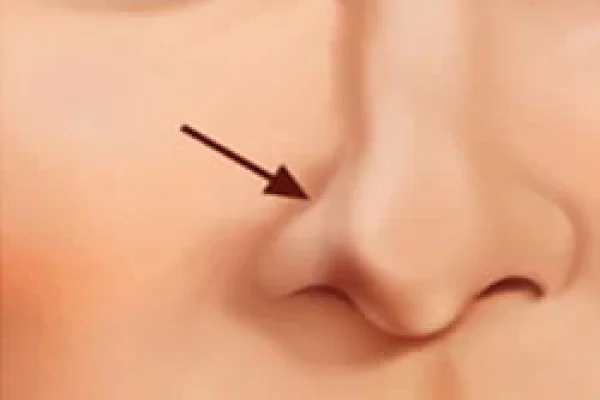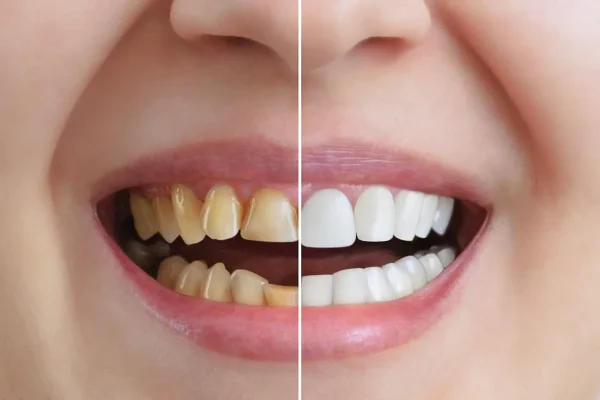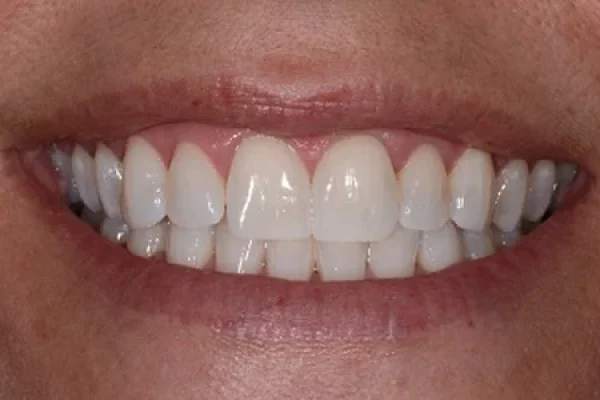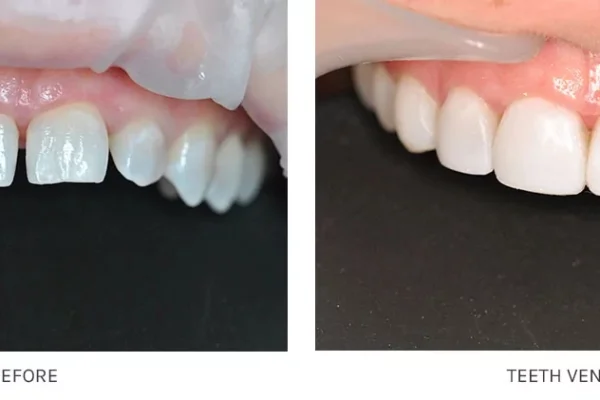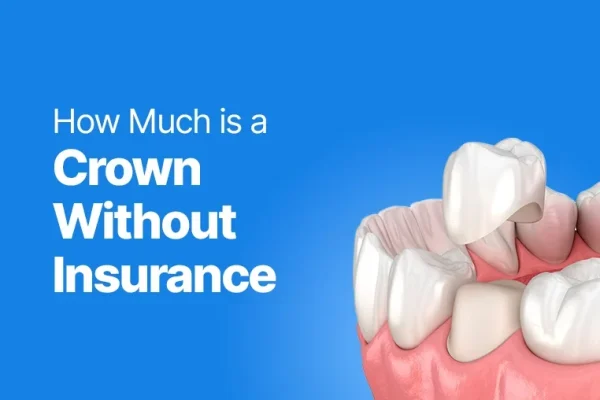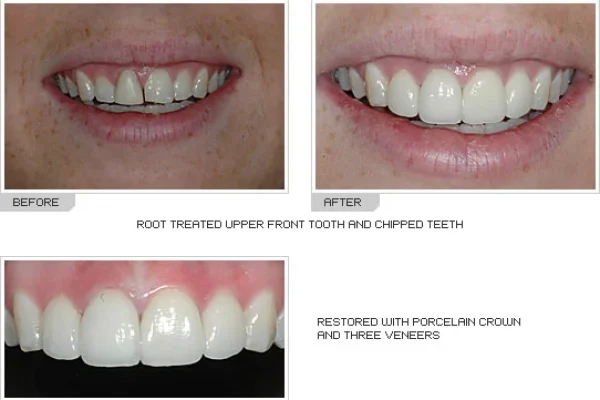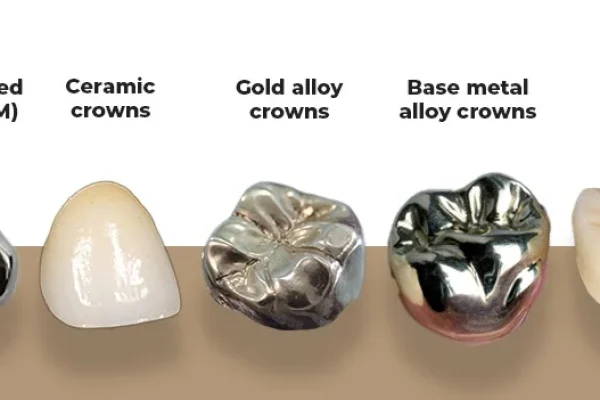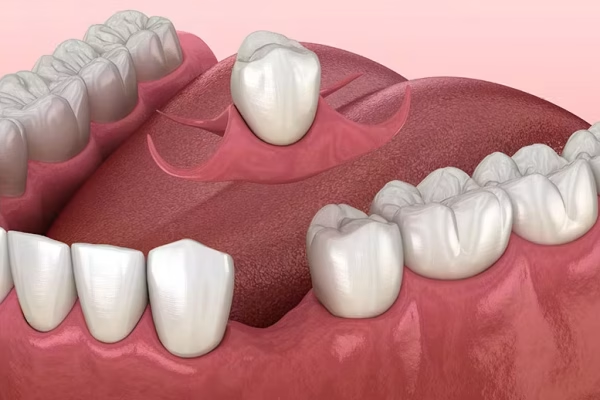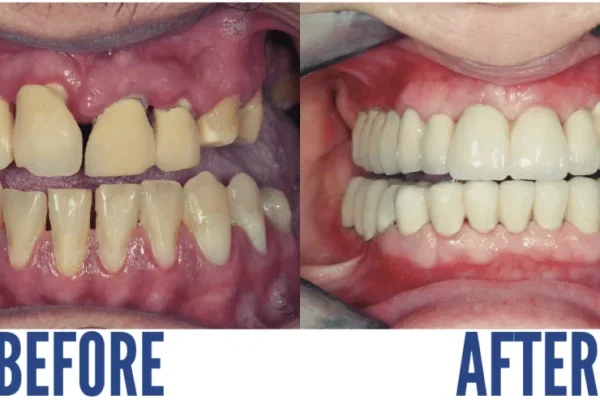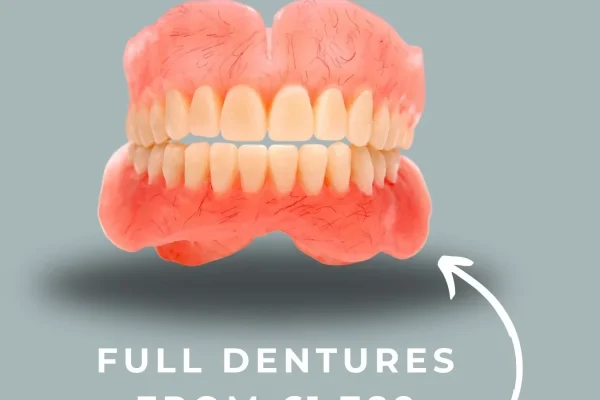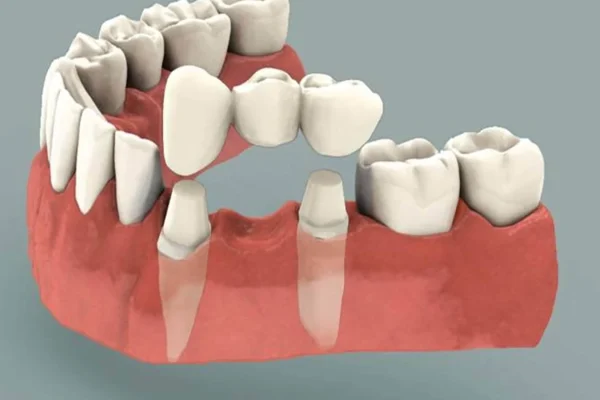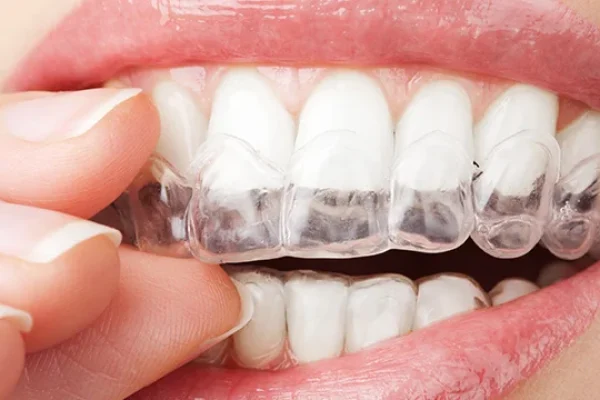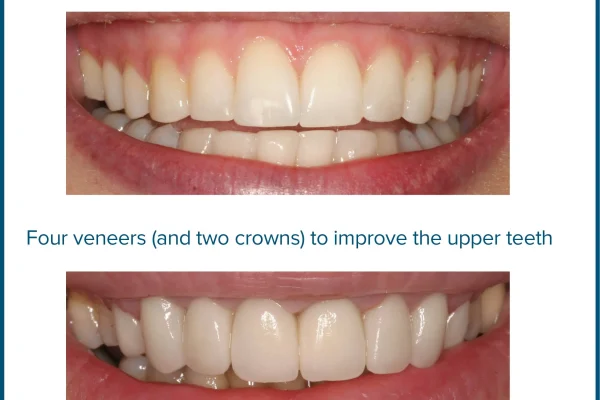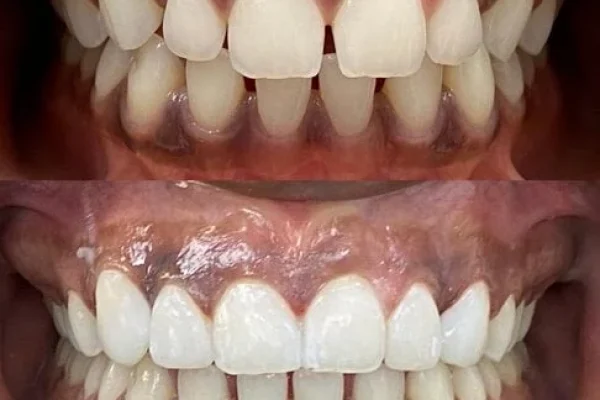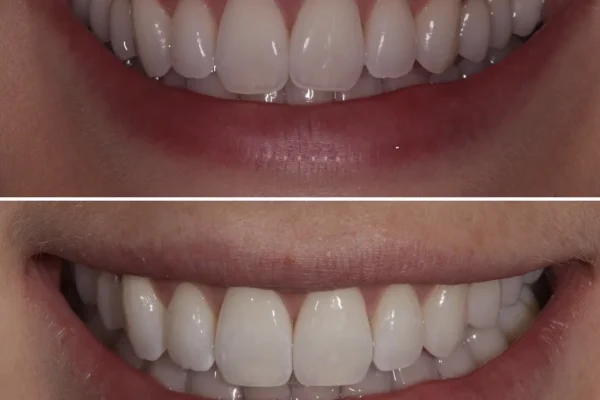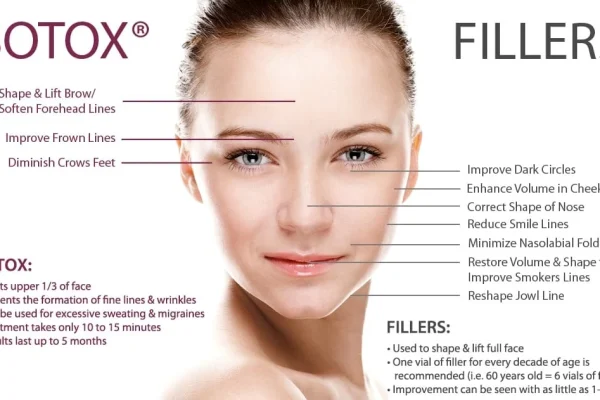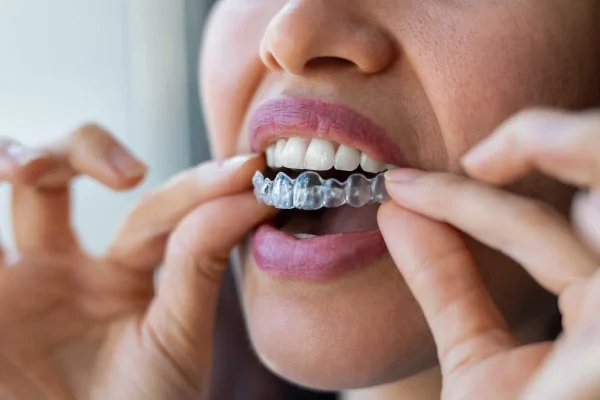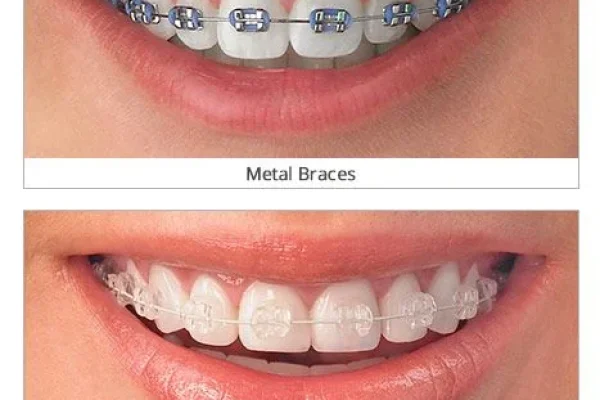
Key Takeaways
- Dental bonding is a cosmetic procedure using tooth-coloured resin to fix imperfections like chips, gaps, or discolouration, often completed in a single visit with minimal tooth alteration.
- The cost for dental bonding in the UK typically ranges from £150 to £400 per tooth, depending on the complexity of the work and the dental practice.
- Bonding is generally a painless procedure that doesn’t require anesthesia for most cosmetic applications, and when done well, bonded teeth look very natural.
- Bonded teeth can last 3 to 10 years but are more prone to staining and chipping than porcelain veneers; they do not respond to teeth whitening treatments.
- Proper care, including good oral hygiene and avoiding hard or staining foods, is crucial for maintaining the appearance and longevity of bonded teeth.
So, you’re navigating the labyrinth of cosmetic dentistry, and the term “bonded teeth” keeps popping up, shimmering like a freshly polished incisor under a spotlight. What’s the deal? Is it a fleeting trend, or a steadfast solution for those seeking an aesthetic uplift without necessarily remortgaging the house or committing to something as permanent as a life sentence with perfect, yet unnervingly unchangeable, teeth? This guide, consider it your dental Rosetta Stone, is here to demystify “bonded teeth,” transforming bewildering jargon into bitesize, digestible truths. We’re talking about a pathway to a more confident smile, one that doesn’t always scream “I’ve had work done!” but rather whispers, “Yes, my teeth are naturally this charming.” Forget the old wives’ tales and the marketing fluff; we’re cutting through to the core of what dental bonding offers. It’s about understanding not just the ‘what’ but the ‘why,’ the ‘how,’ and, crucially, the ‘is it right for me?’. This isn’t just about filling gaps or fixing chips; it’s about artistry meeting science, right there in your mouth. We’ll explore the nitty-gritty, from the materials used to the longevity you can expect, and the kind of care that keeps bonded teeth looking their best. Prepare to have your questions answered, your curiosities sated, and perhaps, your next dental appointment booked with a newfound clarity. This is your deep dive into the world of dental bonding, a cosmetic procedure that has revolutionized smile makeovers with its conservative approach and impressive results, often in a single visit. It’s a favoured option for many seeking to enhance their smile’s aesthetics without the extensive preparation or cost associated with other, more invasive procedures, offering a versatile way to address a multitude of minor imperfections with finesse and a remarkably natural finish.
What Exactly Are Bonded Teeth and How is the Tooth Bonding Procedure Performed?
Let’s get down to brass tacks, or perhaps, resin tacks in this instance. “Bonded teeth” – it sounds rather like something out of a sci-fi flick, doesn’t it? But the reality is far more grounded, albeit impressively sophisticated. When we talk about “bonded teeth,” we’re referring to natural teeth that have undergone a cosmetic dental procedure known as dental bonding. This process predominantly utilizes a material called “composite resin teeth,” or simply “composites teeth,” which is a durable, tooth-coloured plastic material that can be skillfully sculpted and polished to match the surrounding natural teeth. So, “what is dental bonding?” you ask. Imagine an artist with a palette, not of paints, but of varying shades of this putty-like resin. The dentist applies this resin to your tooth, or teeth, to repair damage, alter shape, close gaps, or improve discolouration. It’s then hardened using a special light, effectively ‘bonding’ the material to the tooth. And “What are bonded teeth?” in essence? They are your own teeth, just enhanced, repaired, or aesthetically tweaked using this ingenious method. It’s particularly popular for “dental bonding front teeth” or “bonding front teeth” because these are the stars of your smile, the ones that catch the light and the eye. The beauty of bonding lies in its conservative nature; often, minimal to no natural tooth enamel needs to be removed. It’s a meticulous process, demanding a keen eye for detail and a steady hand from your dental professional, transforming imperfections into a seamless, natural-looking smile enhancement. The versatility of composite resin allows it to be used for a wide array of cosmetic fixes, from the tiniest chip repair to more comprehensive aesthetic reshaping, making it a cornerstone of modern minimally invasive cosmetic dentistry and a go-to for those seeking immediate, visible improvements. This approach prioritizes the preservation of your natural tooth structure, which is always a win in the dental world.
What is the Step-by-Step Dental Bonding Process Like from Start to Finish?
So, you’re intrigued by the prospect of dental bonding, but the thought of the actual “doing” part might have you picturing a complex, lengthy ordeal. Let’s demystify the “what happens during dental bonding?” question with a clear, step-by-step walkthrough, because understanding “How Does Composite Bonding Work?” can significantly ease any apprehension. First off, preparation is surprisingly minimal. Unlike more invasive procedures, significant alteration of your natural tooth is rarely necessary. Your dentist will begin by selecting a shade of composite resin that meticulously matches the natural colour of your teeth – this is where the artistry truly begins. Next, the tooth surface (or teeth surfaces) to be bonded will be gently etched. This isn’t as aggressive as it sounds; it’s a mild roughening of the enamel which creates microscopic pores. This step is crucial because it allows the bonding agent to adhere more securely. Following the etching, a conditioning liquid is applied. Think of this as the primer before the paint; it helps the composite resin stick firmly to the tooth. Now for the star of the show: the tooth-coloured resin itself. This putty-like material is applied to the tooth in layers, and your dentist will skillfully sculpt and mould it to the desired shape, whether it’s filling a chip, closing a gap, or reshaping a tooth. Once the resin is perfectly placed, a special high-intensity curing light (often a blue light) is used. This light activates a catalyst in the resin, causing it to harden and cure within seconds. This process might be repeated if multiple layers are needed to achieve the desired thickness and contour. Finally, once the resin is fully hardened, your dentist will perform the final touches. This involves further trimming, shaping, and polishing the bonded material until it blends seamlessly with your natural tooth enamel, achieving a smooth, natural lustre. The aim is for the bonded area to be indistinguishable from your other teeth, both in appearance and feel. It’s a dance of precision and aesthetics.
How Painful is Dental Bonding, and is Anesthesia Typically Required?
The P-word: pain. It’s often the first gremlin that whispers anxieties when any dental procedure is mentioned. So, “How painful is dental bonding?” The good news, and it’s genuinely good news, is that for most cosmetic dental bonding applications, the procedure is virtually painless. Because the process typically involves working on the surface of the tooth and doesn’t usually require drilling deep into the tooth structure (especially for common aesthetic fixes like chips, gaps, or minor reshaping), there’s rarely any discomfort that would necessitate local anesthesia. You might feel some minor sensations, like the etching solution or the air used to dry the tooth, but these are generally not described as painful. Think of it more like a meticulous sculpting session for your tooth rather than an invasive operation. Now, there are exceptions. If the bonding is being used to fill a decayed tooth (a composite filling), then yes, anesthesia would likely be administered to numb the area, just as it would for any other type of filling where decay needs to be removed. But for purely cosmetic enhancements on healthy teeth, numbing is often entirely unnecessary. This directly addresses the question, “Do they put you to sleep for teeth bonding?“. The answer is a resounding no for general anesthesia. Local anesthesia might be used in specific cases (like cavities), but you’ll be awake and aware throughout the procedure, which is usually quite quick. This pain-free aspect is one of the significant draws of dental bonding for many patients seeking a comfortable and convenient path to an improved smile, removing a major barrier for those with dental anxieties. The focus is on enhancing your smile without adding undue stress or discomfort, making it a remarkably patient-friendly option.
Do They Need to Shave Your Teeth for Composite Bonding?
This is a very common and understandable concern: “Do they shave your teeth for composite bonding?” The mental image of your precious enamel being ground down can be quite alarming. However, one of the standout advantages of composite bonding, especially when compared to alternatives like porcelain veneers, is its remarkably conservative approach to your natural tooth structure. In most cases, especially for additive procedures like closing small gaps or repairing minor chips, there is absolutely no need to “shave” or significantly reduce your natural tooth enamel. The composite resin material is designed to bond directly to the existing tooth surface. The “preparation” that does occur is typically very minimal. As mentioned earlier, the tooth surface might be slightly roughened with a mild etching solution. This isn’t about removing enamel in the way one might for a crown or veneer; it’s about creating a more receptive surface at a microscopic level to ensure a strong, durable bond between the resin and your tooth. Think of it like lightly sanding a piece of wood before painting it – you’re not changing the shape of the wood, just helping the paint adhere better. This minimally invasive nature means the procedure is often reversible, as the underlying tooth structure remains largely intact. This contrasts sharply with traditional veneers, which usually require a more significant portion of the tooth’s front surface to be removed to accommodate the thickness of the porcelain shell. So, rest assured, the aggressive “shaving” you might be picturing is generally not part of the composite bonding protocol, making it a tooth-preserving champion in the world of cosmetic dentistry. This focus on preserving natural tooth tissue is a key principle of modern dentistry, and bonding aligns perfectly with this ethos.
Does Dental Bonding Cover the Entire Tooth or Only Specific Areas?
When you hear “dental bonding,” you might wonder about the extent of the application: “Does bonding go over the whole tooth, like a tiny helmet, or is it more of a targeted fix?” The answer is: it depends entirely on the cosmetic goal and the specific issue being addressed. Dental bonding is incredibly versatile in this regard. It can be meticulously applied to very specific, small areas – for instance, to repair a tiny chip on the edge of a tooth, to fill a small pit or groove, or to close a minor gap between two teeth. In these cases, the resin is carefully sculpted just where it’s needed, blending seamlessly with the surrounding natural tooth structure. However, dental bonding can also be used to cover a larger portion of the tooth surface, or even the entire front surface, if the goal is more comprehensive cosmetic reshaping, to change the tooth’s color, or to make a crooked tooth appear straighter. This is sometimes referred to as composite veneering or direct composite veneers. Even in these more extensive applications, the approach is often still more conservative than traditional porcelain veneers, as the dentist sculpts the material directly onto the tooth. So, it’s not necessarily an all-or-nothing situation. The beauty of bonding lies in its adaptability. It’s not always a full tooth covering like a dental crown, which encases the entire visible portion of the tooth. Instead, bonding offers a tailored solution, addressing only the areas that require aesthetic improvement, thus preserving as much of your healthy, natural tooth as possible. This precision makes it an efficient and effective treatment for a wide spectrum of cosmetic concerns, from minute corrections to more transformative smile enhancements. The skill of the dentist lies in artfully applying the resin exactly where it will make the most impact.
Can Tooth Bonding Be Done in a Single Visit to the Dentist?
In our fast-paced world, convenience is king, and dental procedures are no exception. So, the question “Can tooth bonding be done in one visit?” is a pertinent one for many considering this cosmetic enhancement. The answer, happily, is almost always a resounding yes. One of the most significant advantages of dental bonding is its efficiency. For most common applications – repairing chips, closing gaps, minor reshaping of one or several teeth – the entire procedure, from shade selection to final polish, can typically be completed in a single appointment at your dentist’s office. This is a major draw compared to treatments like porcelain veneers or crowns, which often require multiple visits spread out over weeks, involving impressions, temporary restorations, and lab fabrication time. With bonding, the magic happens chairside, directly on your teeth. “How long does composite bonding take?” will, of course, vary depending on the complexity of the case and the number of teeth being treated. A simple chip repair on one tooth might take as little as 30 to 60 minutes. If you’re having multiple teeth bonded or more intricate reshaping is required, the appointment will naturally be longer, potentially a couple of hours. However, the ability to walk in with a cosmetic concern and walk out with a transformed smile in just one sitting is a powerful benefit. This immediate gratification, combined with the minimally invasive nature of the procedure, makes dental bonding an incredibly attractive option for those seeking swift, effective cosmetic improvements without a lengthy treatment timeline. It streamlines the path to a better smile, minimizing disruption to your schedule.
Why Might You Choose Dental Bonding and What Are Its Key Advantages for Your Smile?
When considering a cosmetic dental procedure, the “why” is just as crucial as the “how.” So, why might dental bonding be the shining knight for your smile aspirations? The advantages are compelling and cater to a wide range of needs and desires. Firstly, and often most appealingly, is its minimally invasive nature. As we’ve touched upon, bonding typically requires little to no removal of your precious natural tooth enamel. This isn’t just about preserving tooth structure; it means the procedure is often reversible and generally more comfortable. Secondly, cost-effectiveness is a huge plus. Compared to alternatives like porcelain veneers or crowns, dental bonding is usually significantly more affordable. This makes achieving a smile enhancement accessible to a broader audience who might find other cosmetic options financially prohibitive. Versatility is another key advantage. “What are the advantages of dental bonding?” Well, its ability to fix a multitude of sins is high on the list – from repairing chips and cracks, to closing gaps (“composite bonding for gaps“), to concealing discolouration, and even reshaping slightly misaligned or uneven teeth. This adaptability makes it a go-to solution for many minor to moderate cosmetic concerns. Furthermore, the speed of treatment, as discussed, is a massive draw. Often completed in a single visit, you can walk out with a transformed smile almost immediately. This answers the question “Why Choose Composite Bonding?” for those seeking quick results. In answering “Is bonding good for your teeth?“, its conservative approach that prioritizes tooth preservation certainly leans towards a “yes,” especially when compared to more aggressive treatments. The aesthetic results can also be outstanding. A skilled dentist can meticulously match the composite resin to your natural tooth colour and translucency, creating a virtually undetectable repair or enhancement. It’s a testament to how far dental materials and techniques have come, offering a blend of art and science for your smile. The direct application also means your dentist has complete control over the final shape and look, allowing for highly customized results.
Who is a Suitable Candidate for Dental Bonding, and Are There Any Eligibility Restrictions?
Dental bonding is a fantastic option for many, but like any medical or dental procedure, it’s not a one-size-fits-all solution. Understanding who makes an ideal candidate can save you time and set realistic expectations. Generally, individuals with good overall oral health – meaning healthy gums and teeth free from extensive decay or active gum disease – are prime candidates for cosmetic bonding. If you have minor cosmetic imperfections that you’d like to address, bonding could be your hero. This includes issues like small chips or cracks in teeth, slight discolouration that hasn’t responded to whitening, gaps between teeth (diastemas), teeth that are slightly misshapen or shorter than others, or even minor to moderate wear. “Who Requires Teeth Bonding?” is perhaps better phrased as “Who benefits most from teeth bonding?“. It’s often those seeking a conservative, cost-effective, and quick fix for aesthetic concerns that don’t necessarily warrant more extensive treatments like veneers or crowns. For example, if you have a perfectly healthy tooth that just has an annoying little chip on the edge from an accidental encounter with a fork, bonding is an excellent, minimally invasive way to restore its appearance. Similarly, if you have small, naturally occurring gaps between your front teeth that you’re self-conscious about, bonding can artfully close them. The key is that the underlying tooth structure should be sound. Bonding is primarily an aesthetic and minor restorative procedure; it’s not typically used for major reconstructions or to repair severely damaged or weakened teeth, as these situations might require the greater strength and coverage of a crown. A thorough consultation with your dentist is essential to determine if bonding is the most appropriate and effective treatment for your specific dental situation and smile goals. They will assess your oral health, discuss your aesthetic aspirations, and outline all viable options.
Who Cannot Have Composite Bonding or Might Not Be a Good Fit for This Treatment?
While composite bonding is a versatile and popular choice, it’s crucial to understand that it isn’t universally suitable. So, “Who cannot have composite bonding?” or “Who is not suitable for dental bonding?” These are important questions to address to ensure patients have realistic expectations and are guided towards the most appropriate treatment for their needs. Firstly, individuals with poor oral hygiene or active dental problems like extensive tooth decay or gum disease (periodontitis) are generally not immediate candidates. These underlying issues must be treated and resolved before cosmetic procedures like bonding can be considered. Applying bonding over unhealthy teeth or gums would be like painting over rust – it doesn’t fix the fundamental problem and can even exacerbate it. Secondly, those with very severe tooth damage, such as large fractures or extensively worn down teeth, might find that bonding doesn’t offer sufficient strength or durability. In such cases, more robust restorations like crowns or onlays may be necessary to protect the tooth and restore its function adequately. People who are heavy smokers or consume large quantities of staining foods and drinks (like coffee, tea, red wine) should also be aware that composite resin can be more prone to staining over time compared to porcelain. While regular polishing can help, if stain resistance is a top priority, other options might be discussed. Furthermore, individuals with bruxism (chronic teeth grinding or clenching) may not be ideal candidates, especially for bonding on biting surfaces or front teeth, as the excessive forces can cause the bonding material to chip, crack, or wear down prematurely. A nightguard might be recommended, or an alternative, more durable material might be considered. Finally, if the cosmetic concerns are very extensive or involve significant misalignment, orthodontic treatment (like braces or clear aligners) might be a more appropriate first step before considering bonding for final refinements.
Can You Have Composite Bonding on Existing Crowns or if You Have Crooked Teeth?
This is where the nuances of dental treatment planning come into play. Let’s tackle “Can you have composite bonding on crowns?” first. Generally, bonding composite resin directly to porcelain or metal crowns can be challenging. The bond strength achieved between composite resin and these non-enamel surfaces is typically not as strong or predictable as the bond to natural tooth enamel. While it might be technically possible in some very specific, limited circumstances as a temporary fix or minor repair to a chipped crown, it’s not usually a recommended long-term solution for altering the shape or color of an existing crown. If a crown is damaged or aesthetically unsatisfactory, replacing the crown itself is often the more durable and reliable option. Your dentist would need to assess the specific situation, the material of the crown, and the desired outcome to advise appropriately. Now, regarding crooked teeth: “Do you need straight teeth for composite bonding?” and “Can you have composite bonding on crooked teeth?“. This is a bit more flexible. For very minor misalignments or slightly rotated teeth, composite bonding can sometimes be skillfully used to create the illusion of a straighter smile. By strategically adding resin to certain areas, a dentist can alter the perceived shape and alignment of teeth, making them appear more uniform. This is often a quicker and less expensive alternative to full orthodontic treatment for subtle corrections. However, it’s important to understand that bonding doesn’t actually move the teeth or correct the underlying bite issues; it’s a camouflage technique. If the teeth are significantly crooked, crowded, or if there are substantial bite problems, orthodontic treatment (like braces or Invisalign) would be the more appropriate and healthier long-term solution. Sometimes, bonding is used after orthodontic treatment to perfect the shapes of teeth once they are in the correct position.
What Specific Dental Imperfections Can Composite Bonding Effectively Correct or Improve?
Dental bonding is akin to a versatile artist’s toolkit for the smile, capable of addressing a surprising array of minor to moderate aesthetic dental imperfections with finesse. When patients ask, “What is composite bonding used for?“, the list of applications is quite extensive, making it a popular choice for those seeking targeted improvements without resorting to more invasive procedures. One of its most celebrated uses is the repair of chipped or cracked teeth. Whether it’s a minor mishap from biting on something hard or a slight imperfection that’s always been there, bonding can seamlessly restore the tooth’s original shape and integrity, making the damage virtually disappear. Another significant application is closing gaps or spaces between teeth, technically known as diastemas. For individuals self-conscious about “composite bonding for gaps” or a “composite bonding teeth gap,” particularly between the front teeth, this procedure offers a swift and effective solution, creating a more uniform and harmonious smile line without the need for orthodontics in many cases. Discoloured teeth that haven’t responded well to traditional whitening methods can also benefit from bonding. The dentist can select a shade of composite resin that is lighter and brighter, applying it to the tooth surface to mask stubborn stains or intrinsic discolouration, thereby enhancing the overall brightness of the smile. Furthermore, bonding can be used to alter the shape or size of teeth. If teeth are slightly misshapen, too small, or uneven in length, composite resin can be skillfully sculpted to make them appear more symmetrical and proportionate with the rest of the smile. It can even be used to make teeth appear slightly longer or to correct minor irregularities in their alignment, offering a subtle yet impactful aesthetic improvement. This adaptability makes it a cornerstone in cosmetic dentistry for achieving precise and personalized smile enhancements.
Can Front Teeth Be Bonded, Especially to Repair Chips or Minor Flaws?
Absolutely, and in fact, front teeth are among the most common beneficiaries of dental bonding. When you consider the visibility and aesthetic impact of your anterior teeth, it’s no surprise that even minor imperfections can feel quite prominent. So, to directly answer “Can front teeth be bonded?” – yes, they certainly can, and it’s an incredibly effective way to address a variety of cosmetic concerns that affect these prominent smile-makers. The question “Can chipped front teeth be bonded?” also gets a resounding affirmative. A chip on a front tooth, no matter how small, can significantly affect one’s confidence. Dental bonding offers a fantastic solution for this, as the composite resin can be meticulously matched to the natural shade and translucency of your tooth, then sculpted to recreate the lost portion, blending seamlessly with the original tooth structure. The repair can be so precise that it becomes virtually invisible. This addresses the keywords “dental bonding front teeth” and “bonding front teeth” perfectly, as this is a prime application. Beyond just chips, bonding on front teeth can correct minor cracks, small gaps, slight discolourations, or even subtle misaligngments, improving the overall symmetry and appeal of your smile. Because the procedure is generally conservative, often requiring minimal to no removal of healthy tooth enamel, it’s a favoured approach for preserving the integrity of these vital teeth while enhancing their appearance. The artistry of the dentist truly shines when working on front teeth, as achieving a natural and harmonious result is paramount. It’s a testament to how a relatively simple procedure can make a dramatic difference to one’s smile and self-esteem.
Is Dental Bonding an Effective Solution for Worn Down Teeth or Gaps Between Teeth?
Dental bonding proves itself to be a remarkably versatile and effective solution for a range of aesthetic concerns, including worn down teeth and those unwelcome gaps. Addressing “Can bonding fix worn down teeth?“, the answer is often yes, particularly when the wear is minor to moderate. Over time, teeth can become shorter or develop uneven edges due to grinding (bruxism), acid erosion, or simply years of use. Composite bonding can be skillfully applied to the biting edges or surfaces of these worn teeth to restore their original length and shape, not only improving their appearance but also potentially protecting them from further wear in some instances. The dentist can rebuild the lost tooth structure layer by layer, creating a natural-looking and functional restoration. However, if the wear is severe or indicative of a significant underlying issue like an aggressive grinding habit, other treatments or protective measures (like a nightguard) might be recommended in conjunction with, or instead of, bonding to ensure a durable outcome. Now, let’s talk gaps. The efficacy of bonding in closing diastemas (gaps between teeth) is one of its most celebrated applications, directly addressing queries about “composite bonding for gaps.” Whether it’s a prominent gap between the two front teeth or smaller spaces between other teeth, composite resin can be artfully sculpted to widen the teeth on either side of the gap, effectively closing the space and creating a more continuous, harmonious smile. This is often achieved in a single visit and without the need for orthodontic treatment, making it a quick and cost-effective solution for many individuals bothered by such spaces. The key is the dentist’s skill in shaping the resin to look natural and proportionate.
What is the Expected Aesthetic Outcome of Dental Bonding: Will My Teeth Look Natural?
This is, quite understandably, a paramount concern for anyone considering cosmetic dental work: will the results look beautifully authentic, or will they scream “artificial“? The goal of dental bonding, when performed by a skilled cosmetic dentist, is precisely to achieve an aesthetic outcome that is virtually indistinguishable from your natural teeth. The success of this hinges on several factors, primarily the dentist’s artistry and the quality of the materials used. Modern composite resins are available in a vast array of shades, translucencies, and opacities, allowing the dentist to meticulously select a combination that perfectly matches your existing teeth. It’s not just about a single flat colour; natural teeth have subtle variations in shade and translucency, especially towards the biting edge, and a skilled practitioner can replicate these nuances with composite resin. They can layer different shades and opacities to mimic the depth and vitality of natural enamel and dentin. The final polishing stage is also crucial; it imparts a smooth, light-reflecting surface that mimics the lustre of natural tooth enamel. So, if your primary worry is ending up with teeth that look “done” or out of place, rest assured that the aim of quality dental bonding is the exact opposite. It’s about subtle enhancement, seamless integration, and a result that boosts your confidence precisely because it looks so effortlessly natural. The skill of your dentist in colour matching, sculpting, and polishing is paramount to achieving this beautiful, lifelike result, transforming imperfections into a smile that is both enhanced and authentically yours. Discussing your expectations with your dentist and perhaps looking at before-and-after photos of their previous bonding work can provide further reassurance.
Do Bonded Teeth Look Fake, or Can They Achieve a Natural Appearance?
The million-dollar question for many is, “Do bonded teeth look fake?” It’s a valid fear. Nobody wants a smile that looks like it belongs to a mannequin or draws attention for all the wrong reasons. The fantastic news is that when dental bonding is performed with skill and artistry, the results can be incredibly natural-looking, to the point where even you might forget which tooth was treated! The ability to “achieve a natural appearance” is one of the hallmarks of well-executed composite bonding. How is this natural look achieved? Firstly, as mentioned, the composite resin material itself has evolved significantly. Modern resins come in a wide spectrum of shades and translucencies. A good cosmetic dentist will take considerable care in selecting a shade (or multiple shades, if layering for depth) that precisely matches your surrounding natural teeth. They don’t just pick a generic “white”; they consider the subtle hues and characteristics of your unique smile. Secondly, the application technique is crucial. It’s not just about slapping on some material. The dentist sculpts the resin, mimicking the natural contours, curves, and even the slight imperfections that make teeth look real. They might recreate mamelons (the subtle ridges on the biting edges of new incisors) or the way light reflects off different parts of the tooth. Thirdly, the final polishing is key to mimicking the natural lustre of tooth enamel. A poorly polished bond can look dull or opaque, but a well-polished one will gleam just like a healthy, natural tooth. So, while a poorly done bonding job could potentially look fake or obvious, the goal and typical outcome of professional composite bonding is a seamless, beautiful, and entirely natural enhancement to your smile.
Do Bonded Teeth Turn Yellow Over Time, or Do They Stay White?
This is a practical and important consideration: the long-term colour stability of your newly enhanced smile. So, “Do bonded teeth turn yellow?” and “Does teeth bonding stay white?” The answer lies somewhere in the middle, with a strong emphasis on care and habits. Composite resin, the material used in dental bonding, is quite stain-resistant, especially the newer, more advanced formulations. When first placed and polished, it will match your natural teeth beautifully. However, it’s not entirely impervious to staining over time, particularly when compared to materials like porcelain (used in veneers and crowns), which is highly resistant to discolouration. Over several years, composite bonding can gradually pick up stains from strongly pigmented foods and drinks like coffee, tea, red wine, curry, and berries. Smoking is also a significant factor that can lead to yellowing or browning of both natural teeth and bonded restorations. So, while they don’t “turn yellow” overnight, and they certainly aim to “stay white” (or rather, stay the carefully matched shade they were originally), their colour stability is influenced by your lifestyle choices and oral hygiene habits. Regular professional cleanings at your dentist’s office can help remove superficial surface stains and keep your bonded teeth looking their best. Meticulous home care – brushing twice a day, flossing daily, and considering a non-abrasive whitening toothpaste (though this won’t whiten the bond itself, it helps keep surrounding teeth and the bond surface clean) – is also crucial. If significant staining does occur after several years, the bonding can sometimes be polished to remove it, or in some cases, it might need to be replaced or resurfaced to restore its original appearance.
How Long Do Bonded Teeth Typically Last, and Is Dental Bonding Considered a Permanent Fix?
When investing in your smile, longevity is naturally a key concern. You’ll want to know, “How long do bonded teeth last?” and get a clear picture of its durability. Dental bonding is considered a durable and effective solution, but it’s not typically marketed as a “permanent” fix in the same way that, say, a dental implant might be considered a lifetime solution (though even those have caveats). On average, you can expect dental bonding to last anywhere from 3 to 10 years, and sometimes even longer, before it may need to be touched up or replaced. “How Long Does Dental Bonding Last?” isn’t a question with a single, definitive answer because several factors come into play. These include the location of the bonding (front teeth used for biting into apples will experience more stress than bonding on a non-biting surface), the extent of the bonding (a small chip repair might last longer than a full resin veneer), your oral hygiene habits (meticulous care prolongs its life), your dietary habits (avoiding very hard foods or using teeth as tools), and whether you clench or grind your teeth (bruxism can significantly shorten its lifespan). So, when considering, “Is bonding on teeth permanent?“, the answer is generally no, not in the sense of lasting indefinitely without any further attention. Think of it as a semi-permanent solution that offers excellent aesthetic results for a significant period but will likely require maintenance or replacement down the line to keep your smile looking its best. Regular dental check-ups are vital, as your dentist can monitor the condition of the bonding and advise on any necessary repairs or replacements. The good news is that re-bonding or repairing existing bonding is usually a straightforward process.
What Can You Expect After 5 Years of Having Composite Bonding?
Peering into the crystal ball, or rather, relying on clinical experience, what can you expect “after 5 years of composite bonding?” This timeframe often serves as a good checkpoint. By the five-year mark, well-maintained composite bonding can still be looking fantastic and functioning perfectly. Many patients find their bonded teeth continue to enhance their smile beautifully. However, this is also a point where some natural wear and tear might start to become noticeable, depending on the factors mentioned earlier (diet, habits, location of the bond). You might observe some slight loss of the initial high-gloss polish, especially if you consume a lot of abrasive foods or use abrasive toothpastes. There could be some minor staining or discolouration, particularly if you’re a regular consumer of coffee, tea, red wine, or if you smoke. The margins of the bonding (where it meets the natural tooth) might become slightly more discernible. In some cases, especially on biting edges or in individuals who clench or grind, small chips or areas of wear might have appeared. This doesn’t necessarily mean the entire bond needs replacing. Often, these minor issues can be addressed with simple polishing to restore lustre and remove surface stains, or a small touch-up or repair to fix a chip. Your dentist will assess the integrity of the bonding during your regular check-ups. For many, at 5 years, the bonding is still going strong, but it’s a good milestone to be aware that future maintenance might be on the horizon to keep it looking its absolute best, reaffirming that it’s a durable but not indefinite solution.
Can Dental Bonding Come Off or Break Easily Under Normal Conditions?
This is a crucial question related to durability: “Can dental bonding come off?” and “Does dental bonding break easily?” While dental bonding material is quite strong and designed to adhere securely to the tooth, it’s not indestructible, nor is it as robust as natural, untouched enamel or porcelain restorations like veneers or crowns. Under normal conditions – regular chewing, speaking, and good oral hygiene – dental bonding should stay firmly in place and resist breakage. The etching and bonding process creates a very strong micromechanical lock between the resin and the tooth. However, “coming off” (debonding) or breaking can occur under certain circumstances. The most common culprits for bonding failure include: biting directly into very hard or sharp objects (like ice, hard sweets, pen caps, or using teeth to open packages – a definite no-no!), trauma or injury to the mouth (like a knock during sports), and habitual teeth grinding or clenching (bruxism), which places excessive stress on the bonding material. The location of the bond also plays a role; bonding on the biting edges of front teeth is generally more susceptible to chipping than bonding on the flat surface of a tooth. So, while it doesn’t “break easily” with normal function, it does require a degree of mindfulness. Treating your bonded teeth with a little extra care, similar to how you’d care for natural teeth you want to protect, will go a long way in preventing such issues. If a bond does chip or come off, don’t panic; it can usually be easily repaired or replaced by your dentist, often in a single visit.
How Much Does Teeth Bonding Cost, and What Are the Fees in the UK?
“Is teeth bonding expensive?” is a common query, and the answer is relative. Compared to more extensive cosmetic treatments like porcelain veneers or orthodontic work, dental bonding is generally considered one of the most cost-effective ways to enhance your smile. It often provides a significant aesthetic improvement for a comparatively modest investment. However, the exact “How much is dental bonding fee?” can vary quite widely based on several factors. These include the complexity of the procedure (a tiny chip repair will cost less than completely reshaping multiple teeth), the number of teeth being treated, the geographic location of the dental practice (costs can differ between cities and regions, including within the UK), and the experience and reputation of the dentist performing the procedure. A cosmetic dentist with advanced training and a portfolio of stunning results may command higher fees, reflecting their skill and the quality of materials used. It’s also worth noting that the cost is typically calculated on a per-tooth basis. So, if you’re having multiple teeth bonded, the total cost will naturally be higher. When considering the expense, it’s also wise to factor in the longevity of the bonding and potential future costs for touch-ups or replacements, although the initial outlay is usually much lower than for alternatives. To get an accurate figure, a consultation with a dentist is essential; they can assess your specific needs and provide a detailed treatment plan with associated costs. Many practices also offer financing options to help make the treatment more manageable.
What is the Typical Cost for Composite Bonding Per Tooth in the UK Market?
For those in the United Kingdom, understanding the local market rates is key. When asking “How much does teeth bonding cost in the UK?“, “How much does it cost to bond teeth UK?“, or more specifically, “How much is composite bonding per tooth in the UK?“, it’s important to preface this with the understanding that prices are not standardized and can fluctuate significantly. However, to provide a general ballpark figure, you might expect the cost of composite bonding in the UK to range from approximately £150 to £400 per tooth. Some more complex cases or those performed by highly specialised cosmetic dentists in major cities like London could potentially be higher, perhaps reaching £500 or more per tooth. This variation depends heavily on the factors previously mentioned: the intricacy of the work involved (e.g., simple gap filling versus artistic reshaping of a front tooth), the amount of time the procedure will take, the quality of the composite materials used, and the overheads of the dental practice. For instance, bonding to repair a very small, simple chip might be at the lower end of that scale, while creating a full composite veneer to change the shape and colour of a tooth would be at the higher end. It’s always advisable to get personalised quotes from a few different dental practices. During a consultation, the dentist will assess your teeth, discuss your desired outcome, and provide a precise cost breakdown for your specific treatment plan. Don’t hesitate to ask what’s included in the quoted fee (e.g., follow-up appointments, any initial minor adjustments). Some practices may also offer package deals if multiple teeth are being bonded.
What Are the Potential Disadvantages, Risks, and Safety Concerns Associated with Tooth Bonding?
While dental bonding boasts numerous advantages, it’s essential to have a balanced perspective and understand any potential downsides. Addressing “Are There Any Risks to Tooth Bonding?” and the broader “Disadvantages of Composite Bonding” helps in making a fully informed decision. In terms of general safety, “How Safe Is Dental Composite Bonding?” The procedure itself is considered very safe and minimally invasive. The composite resin materials used are biocompatible and have a long track record of successful use in dentistry. However, like any dental treatment, it’s not entirely without potential drawbacks. One of the main disadvantages is that composite resin is not as stain-resistant as porcelain. Over time, especially with consumption of staining foods/drinks or smoking, the bonded areas can discolour. Secondly, while durable, composite resin is not as strong or wear-resistant as natural enamel or porcelain. This means bonded teeth may be more prone to chipping, fracturing, or wearing down, especially if subjected to excessive force (like biting hard objects or teeth grinding). This can necessitate repairs or replacements sooner than with more robust restorations. Another consideration is that the longevity of bonding, typically 3-10 years, is generally less than that of porcelain veneers, which can last 10-15 years or longer with good care. This means you should anticipate the need for future maintenance or re-treatment. While rare, there’s a minimal risk of allergic reaction to the materials used, though this is uncommon. Also, if bonding is not perfectly contoured and polished, it can potentially irritate the gums or create areas where plaque can accumulate more easily, underscoring the importance of a skilled practitioner and diligent oral hygiene.
Is it Generally Safe to Get Your Teeth Bonded, and Is There a Risk of Teeth Rotting Underneath?
Let’s address the safety aspect head-on: “Is it generally safe to get your teeth bonded?” Yes, dental bonding is widely considered a very safe and conservative cosmetic dental procedure when performed by a qualified dental professional. The materials used, primarily composite resins, are biocompatible and have been extensively tested and used in dentistry for many decades, not just for cosmetic bonding but also for tooth-coloured fillings. The procedure itself is minimally invasive, often requiring little to no removal of healthy tooth enamel, which further contributes to its safety profile by preserving the natural tooth structure. Now, onto a common concern: “Do teeth rot under bonding?” This is a very important question. The risk of tooth decay (rotting) developing under a properly placed and well-maintained dental bond is minimal. When the bonding material is correctly applied, it creates a seal with the tooth surface, preventing bacteria and food particles from seeping underneath. However, if the bond is not perfectly sealed, if it chips or cracks creating a margin where bacteria can enter, or if oral hygiene is poor, then yes, decay can potentially develop along the edges of the bonding or underneath it over time. This is why meticulous application by your dentist and diligent home care (brushing, flossing) along with regular dental check-ups are absolutely crucial. During check-ups, your dentist will examine the integrity of the bonding and the health of the underlying tooth, allowing for early detection and intervention if any issues arise. So, while the procedure itself is safe, the long-term health of the tooth relies on both the quality of the initial work and ongoing maintenance.
What Are the Main Disadvantages or the So-Called “Dark Side” of Composite Bonding?
While “dark side” might sound a tad dramatic, it’s important to honestly address “What are the disadvantages of tooth bonding?” or “What are the disadvantages of teeth bonding?” to provide a complete picture. We’ve touched on some, but let’s consolidate them. Firstly, stain susceptibility: Composite resin, while initially matched beautifully to your teeth, is more porous than porcelain or natural enamel. This means it can absorb stains over time from coffee, tea, red wine, smoking, and certain foods. This can lead to the bonding looking discoloured or different from your natural teeth as years go by, potentially necessitating polishing or replacement to maintain aesthetics. Secondly, durability and strength: While strong enough for most normal functions, composite resin is not as robust as porcelain or your own untouched enamel. It can be more prone to chipping, cracking, or wearing down, especially on biting edges, if you bite into very hard items, or if you have habits like teeth grinding. This means repairs or replacements might be needed more frequently than with, say, porcelain veneers. Thirdly, longevity: As a consequence of the above, the lifespan of composite bonding is generally considered to be shorter than that of porcelain restorations. You might get 3-10 years from bonding, whereas veneers can last 10-15+ years. This means factoring in the potential for future re-treatment costs and time. Fourthly, skill dependency: The aesthetic success of composite bonding is highly dependent on the skill and artistry of the dentist. A less experienced practitioner might not achieve the same natural-looking, seamless results in terms of shade matching, shaping, and polishing. Lastly, while minimal, there’s always the need for maintenance: Regular check-ups and good oral hygiene are paramount to maximize its lifespan and appearance. These aren’t necessarily deal-breakers, but they are crucial factors to weigh when considering if bonding is the right long-term choice for your smile.
How Should You Properly Care for Your Bonded Teeth After the Procedure to Ensure Longevity?
Congratulations, you’ve invested in your smile with dental bonding! Now, the focus shifts to preservation. Proper aftercare is paramount to ensure your bonded teeth maintain their beauty and integrity for as long as possible. Think of it as protecting your investment. The good news is that caring for bonded teeth isn’t overly complicated and largely mirrors the advice for maintaining excellent overall oral health, with a few specific considerations. “How to Take Care of Your Bonded Tooth” or, more broadly, “How to Care for Bonded Teeth” starts with impeccable oral hygiene. This means brushing your teeth at least twice a day with a soft-bristled toothbrush and a non-abrasive fluoride toothpaste. Aggressive brushing or harsh toothpastes can scratch the surface of the composite resin over time, making it dull and more prone to staining. Flossing daily is also crucial, paying careful attention to the areas around the bonding to remove plaque and food debris, which can prevent decay at the margins of the bond and keep your gums healthy. Regular dental check-ups and professional cleanings are non-negotiable. Your dentist and hygienist can professionally polish your bonded teeth, which helps to remove surface stains and maintain their lustre, and they can check the integrity of the bonding, identifying any potential issues early on. Beyond hygiene, be mindful of your habits. Avoid biting directly into very hard foods (like ice, hard sweets, or nuts with shells) with your bonded teeth, especially if the bonding is on your front teeth. Similarly, refrain from using your teeth as tools to open packages or bite fingernails. If you participate in contact sports, wearing a custom-fitted mouthguard is highly recommended to protect your bonded (and natural) teeth from trauma.
Do Bonded Teeth Require Any Special Care or Maintenance After Dental Bonding?
This is a common and practical question: “Do teeth need special care after dental bonding?” While bonded teeth don’t require an entirely different or highly complex care regimen compared to natural teeth, there are some specific nuances and heightened awareness needed to maximize their lifespan and appearance. So, while not “special” in the sense of needing unique, hard-to-find products, they do benefit from mindful care. As outlined, the cornerstones are excellent oral hygiene: brush twice daily with a soft-bristled brush and a non-abrasive toothpaste. Why non-abrasive? Because abrasive particles can scratch and dull the polished surface of the composite resin over time, making it more susceptible to staining and less reflective of light. Floss diligently, especially around the bonded areas, to prevent plaque build-up at the margins where the bonding meets your natural tooth. Regular dental check-ups and professional cleanings every six months (or as recommended by your dentist) are arguably even more important with bonded teeth. During these visits, your hygienist can use special polishing pastes and techniques that are safe for composite resin, helping to remove any superficial stains and restore the shine. Your dentist will also carefully examine the bonding for any signs of wear, chipping, or leakage at the margins. Beyond this, avoiding habits that can damage the bonding is key – no using teeth as tools, no biting on pens or fingernails, and being cautious with extremely hard foods. So, it’s less about “special” tools and more about consistent, gentle, and protective habits.
Can You Eat an Apple with Bonded Teeth, and What Other Lifestyle Adjustments Are Recommended?
The “apple question” – “Can you eat an apple with bonded teeth?” – is a great practical query that gets to the heart of daily life with dental bonding. The short answer is generally yes, you can still enjoy apples and most other foods. However, how you eat certain foods might need a slight adjustment, particularly if you have bonding on your front teeth. Instead of biting directly into a very hard apple with your front bonded teeth, it might be wiser to cut it into slices first. This reduces the direct, concentrated force on the bonded edges, minimizing the risk of chipping. This principle applies to other hard or crunchy foods too – think raw carrots, very crusty bread, or corn on the cob. It’s not that you can’t eat them, but exercising a little caution can go a long way in preserving your bonding. Other lifestyle adjustments primarily revolve around minimizing staining and avoiding undue stress on the restorations. Be mindful of highly pigmented foods and drinks like coffee, tea, red wine, cola, berries, and curry, as composite resin can stain more easily than natural enamel or porcelain over time. Rinsing your mouth with water after consuming these can help. If you smoke, be aware that this is a major factor in staining bonded teeth (and natural teeth, of course). Avoiding habits like chewing on ice, pens, or fingernails is crucial, as these can easily chip or dislodge bonding. If you grind or clench your teeth, especially at night, your dentist will likely recommend a custom-fitted nightguard to protect your bonding (and your natural teeth) from excessive forces. These aren’t drastic changes for most, but rather sensible precautions to ensure your smile investment lasts.
Can You Whiten Bonded Teeth, and How Does the Bonding Material Respond to Color Changes?
This is a very common and important question for anyone who has or is considering dental bonding, especially if they also desire a brighter overall smile: “Can you whiten bonded teeth?” The direct answer is that composite resin, the material used for dental bonding, does not respond to traditional teeth whitening treatments in the same way that natural tooth enamel does. Whitening products, whether over-the-counter or professional-grade, are designed to lighten the colour of natural tooth structure. They typically use peroxide-based agents that penetrate the enamel and break down stain molecules. However, these agents do not change the intrinsic colour of composite resin or other dental restorations like crowns or veneers. This is a crucial piece of information because if you whiten your natural teeth after having bonding done, you could end up with a mismatch in colour – your natural teeth will lighten, but the bonded areas will remain their original shade, potentially making the bonding look more noticeable and artificial. Understanding “How bonding responds to colour” (or rather, how it doesn’t respond to whitening) is key for treatment planning. If you’re considering both whitening and bonding, the ideal sequence is to whiten your natural teeth first to your desired shade. Then, your dentist can select a composite resin shade that matches your newly whitened teeth for the bonding procedure. This ensures a harmonious and uniform colour across your entire smile. If you already have bonding and wish your teeth were whiter, you’d need to discuss options with your dentist, which might involve replacing the existing bonding with a lighter shade after whitening your natural teeth.
Is It Possible to Whiten Bonded Teeth Using Standard Teeth Whitening Treatments?
To reiterate and clarify explicitly: “Is it possible to whiten bonded teeth using standard teeth whitening treatments?” No, unfortunately, it is not. Standard teeth whitening treatments, whether they are professional treatments administered by your dentist (like in-office whitening or custom take-home trays) or over-the-counter products (like whitening strips or toothpastes), are formulated to work on natural tooth enamel. They do not effectively lighten the colour of composite resin materials used in dental bonding, nor do they whiten porcelain veneers or crowns. So, if you apply a whitening product to a smile that includes bonded teeth, your natural teeth may get lighter, but the bonded areas will stubbornly remain their original shade. This can result in a noticeable and often undesirable colour discrepancy, making the dental work more apparent. This is why the timing of whitening procedures in relation to bonding is so critical. If you are planning to have bonding and also want a whiter smile overall, the rule of thumb is to whiten your natural teeth first. Once you’ve achieved your desired level of whiteness and the colour has stabilized (usually a couple of weeks after whitening treatment concludes), your dentist can then perfectly match the composite resin to this new, brighter shade for the bonding procedure. This ensures a seamless and aesthetically pleasing result where the bonding blends invisibly with your whitened natural teeth. If you try to whiten after bonding, you’ll likely be disappointed with the uneven outcome.
Does Composite Bonding Itself Act to Whiten Your Natural Teeth?
This question, “Does Composite Bonding Whiten Teeth?“, addresses a potential misconception. Composite bonding does not inherently whiten your underlying natural teeth. The procedure involves applying a tooth-coloured resin material to the surface of your teeth to repair them, reshape them, or improve their appearance. The colour of the composite resin is chosen by your dentist to either match the existing colour of your natural teeth or, if you’re aiming for an overall brighter smile (and perhaps have whitened your teeth beforehand), to match that desired lighter shade. So, if a lighter shade of composite is used, the bonded area will appear whiter, and this can certainly contribute to a brighter overall smile appearance, especially if multiple teeth are bonded or if the bonding covers a significant portion of the tooth surface. However, the bonding material itself doesn’t have any chemical properties that would bleach or lighten the natural tooth structure underneath or adjacent to it. Think of it like painting a wall: the paint covers the existing colour and gives the wall a new shade, but it doesn’t change the original colour of the wall material itself. If you want your natural teeth to be whiter, that requires a separate teeth whitening procedure. Composite bonding can then be used to match that whiter shade, creating a beautiful, harmonious result, but it’s the whitening treatment that lightens the natural teeth, not the bonding material itself. The bonding is an additive process that covers or alters the appearance of the tooth it’s applied to.
How Does Dental Bonding Compare to Porcelain Veneers as a Cosmetic Option?
When exploring cosmetic dental enhancements, particularly for front teeth, dental bonding and porcelain veneers are often the two leading contenders. Understanding their key differences is crucial for making an informed decision that aligns with your smile goals, budget, and preferences. The core question often boils down to, “Should I Get Dental Veneers Or Dental Bonding?“. Let’s break down the comparison.
Invasiveness: Dental bonding is typically a minimally invasive procedure, often requiring little to no removal of natural tooth enamel. The resin is applied directly to the tooth surface. Porcelain veneers, conversely, usually require a thin layer of enamel to be removed from the front surface of the tooth to accommodate the thickness of the veneer and ensure a flush fit. This makes bonding a more conservative option that often preserves more of your natural tooth structure and is more easily reversible.
Cost: Dental bonding is generally significantly more affordable per tooth than porcelain veneers. Veneers are custom-fabricated in a dental laboratory, which adds to their expense.
Durability & Longevity: Porcelain veneers are known for their superior durability and stain resistance. Porcelain is a very strong, glass-like material that mimics the light-reflecting properties of natural enamel beautifully and is highly resistant to staining from coffee, tea, or smoking. Veneers can last 10-15 years or even longer with proper care. Composite bonding, while durable, is not as strong as porcelain and can be more prone to chipping, wear, and staining over time, typically lasting 3-10 years.
Aesthetics: Both can achieve beautiful, natural-looking results. Porcelain veneers often offer the ultimate in aesthetics due to their translucency and ability to mimic natural enamel precisely. However, a skilled dentist can also achieve stunning results with composite bonding, especially with modern multi-layered techniques.
Treatment Time: Bonding is usually completed in a single visit. Veneers typically require at least two visits – one for preparation and impressions, and another for fitting the custom-made veneers.
Which Cosmetic Treatment is Better for Your Smile Goals: Veneers or Bonding?
Deciding “which cosmetic treatment is better for your smile goals: veneers or bonding?” is not a matter of one being universally superior, but rather which one is the optimal fit for your specific circumstances, priorities, and the dental issues you wish to address. If your primary concerns are minor imperfections like small chips, slight gaps, or minimal reshaping, and you’re looking for a cost-effective, quick, and minimally invasive solution, then dental bonding is often an excellent choice. It allows for targeted corrections, often in a single visit, without significant alteration to your natural teeth. It’s also generally more easily repaired if it does chip. However, if your smile goals involve more extensive transformations, such as correcting more significant discolouration that hasn’t responded to whitening, addressing moderate shape or size discrepancies, or if you desire the utmost in durability and stain resistance, then porcelain veneers might be the better long-term investment, despite the higher initial cost and more invasive preparation. Veneers offer a robust and highly aesthetic solution that can dramatically transform a smile and maintain its beauty for many years. Consider your budget: bonding is more accessible upfront. Consider your long-term expectations: veneers typically last longer and resist stains better. Discuss your tolerance for invasiveness: bonding is more conservative. Your dentist will play a crucial role in guiding this decision by assessing your teeth, discussing your aesthetic aspirations in detail, and explaining the pros and cons of each option as they pertain to your unique case. Sometimes, a combination approach might even be considered. Ultimately, the “better” treatment is the one that best aligns with your individual needs and helps you achieve the confident, beautiful smile you desire.
What Are the Options for Redoing, Removing, or Reversing Dental Bonding Treatment?
A significant advantage of dental bonding, particularly due to its typically conservative nature, is its potential for straightforward management in the long term, including redoing, removal, or even reversal in many cases. Unlike more invasive procedures that involve significant alteration of the natural tooth structure, bonding often leaves the underlying tooth largely intact, which provides more flexibility down the line. If your existing dental bonding becomes stained, chipped, worn, or if you simply desire a change or an upgrade, redoing the bonding is a very common and relatively simple procedure. Your dentist can usually remove the old composite material (often with gentle polishing or abrasion) and then reapply new resin, meticulously matching shades and sculpting it to achieve the desired aesthetic outcome. This can effectively refresh your smile and address any accumulated wear or discolouration. The process is similar to the initial bonding procedure and can often be completed in a single visit. Furthermore, because minimal to no enamel is typically removed during the initial bonding process for many cosmetic applications, the procedure is often considered reversible. This means if you decide you no longer want the bonding, or wish to explore other cosmetic options, the composite material can usually be carefully removed by your dentist, and your natural tooth underneath will be largely in its original state, perhaps just requiring a polish. This reversibility is a significant comfort for many patients who are hesitant to commit to irreversible dental work. This offers a level of flexibility not always available with other cosmetic dental treatments.
If Composite Bonding is Removed, Can You Go Back to Your Natural Teeth?
This is a really reassuring aspect for many considering the procedure: “Can you go back to your natural teeth after composite bonding?” In most cases where dental bonding was applied for purely cosmetic reasons and involved minimal to no alteration of the underlying natural tooth enamel, the answer is yes, you can generally go back to your natural teeth. Because the bonding material is primarily adhered to the surface of the tooth rather than requiring significant removal of tooth structure (as is often the case with porcelain veneers or crowns), its removal typically leaves the original tooth largely intact. When your dentist removes the composite bonding, they will do so carefully, often using fine polishing discs or burs to gently abrade away the resin material without damaging the underlying enamel. Once all the resin is removed, your natural tooth surface will be revealed. “What do teeth look like after bonding is removed?” Ideally, they should look very much like they did before the bonding was ever placed, perhaps just needing a final polish to ensure smoothness. There might be some temporary sensitivity in rare cases, but generally, the tooth returns to its pre-bonded state. This reversibility is a key advantage of dental bonding, making it a less daunting commitment than procedures that permanently alter the tooth. However, it’s important to note that if any tooth reshaping or enamel removal was done as part of your specific bonding procedure (though this is less common for standard cosmetic bonding), then the tooth would not be exactly as it was before. This is why a thorough discussion with your dentist beforehand about the exact preparation involved is crucial.
How Many Times Can a Single Tooth Be Bonded or Have the Bonding Redone?
This question about the repeatability of the procedure, “How many times can a tooth be bonded?” or “How many times can dental bonding be redone?“, is important for long-term planning. Generally, a tooth can be bonded or have its bonding redone multiple times throughout a person’s life. Because the process of removing old bonding and applying new material is typically conservative and doesn’t usually require further significant removal of natural tooth structure (assuming the underlying tooth remains healthy), there isn’t a strict numerical limit like “only three times.” The primary considerations are the health and integrity of the underlying natural tooth. As long as the tooth itself is sound, free from extensive decay, and has sufficient healthy enamel for the resin to bond to, re-bonding is usually a viable option. Each time bonding is redone, your dentist will carefully remove the old material, clean the tooth surface, and then apply the new composite resin. The success of subsequent bonding procedures will depend on the dentist’s skill in removing the old material without damaging the tooth and in creating a fresh, strong bond. However, with each re-treatment, there’s always a theoretical tiny amount of surface manipulation. If a tooth has been bonded many, many times over several decades, or if there are other complicating factors like progressive wear or gum recession, your dentist might eventually discuss alternative long-term solutions if bonding is no longer deemed the most ideal or durable option. But for most practical purposes, re-bonding is a common and effective way to maintain the aesthetic results of dental bonding over many years.
Is Dental Bonding Available on the NHS, and Is It Still a Commonly Performed Dental Procedure?
Understanding the accessibility and current relevance of dental bonding is important for UK residents. Let’s explore its availability within the National Health Service (NHS) and its prevalence in modern dental practice. The question of NHS provision is a frequent one: “Can you get dental bonding on NHS?“. The answer is nuanced. The NHS primarily focuses on providing dental treatments that are clinically necessary to maintain oral health. This means treatments like fillings for decayed teeth, extractions, or dentures fall under its remit. Purely cosmetic procedures – those undertaken solely to improve the appearance of teeth rather than to address a health issue – are generally not covered by the NHS. Dental bonding can sometimes be available on the NHS if it’s deemed clinically necessary. For example, if a front tooth is chipped due to trauma and requires repair for functional or protective reasons, bonding might be offered as an NHS treatment (often as a composite filling/restoration). However, if you’re seeking bonding purely for aesthetic reasons, such as closing small, healthy gaps between teeth or mildly reshaping teeth solely to improve their look, this would typically be considered a private cosmetic treatment and would not be covered by the NHS. You would need to seek this from a private dentist or the private arm of an NHS practice. It’s always best to discuss your specific situation and needs with an NHS dentist to understand what treatment options are available under NHS criteria. They can clarify if your particular case for bonding might meet the clinical necessity threshold or if it would be considered a private procedure.
Can You Typically Get Dental Bonding Treatment Through the NHS in the UK?
To expand on the NHS availability: “Can you typically get dental bonding treatment through the NHS in the UK?” As mentioned, the NHS dental service is primarily designed to provide care that is clinically necessary to protect and maintain oral health, rather than treatments undertaken purely for cosmetic enhancement. Therefore, while dental bonding as a technique is certainly used within NHS practices (for example, for tooth-coloured fillings which are essentially a form of bonding), its application for purely aesthetic purposes – like closing minor cosmetic gaps, subtly changing tooth shape for looks alone, or masking slight discolourations on otherwise healthy teeth – is generally not covered by the NHS. If bonding is required to repair a fractured tooth that is causing pain or functional issues, or to restore a tooth damaged by decay, then it might fall under NHS provision as a restorative treatment. However, if your desire for bonding stems from a wish to improve the cosmetic appearance of your smile without an underlying clinical necessity as defined by NHS guidelines, you would almost certainly need to pursue this as a private treatment. This means you would be responsible for the full cost of the procedure. Many dental practices offer both NHS and private treatment options, so you can discuss with your dentist whether your specific needs align with NHS criteria or if private treatment would be the route for your desired cosmetic bonding. It’s crucial to have this conversation to clarify expectations regarding coverage and cost.
Do Dentists Still Commonly Offer and Perform Tooth Bonding Procedures Today?
Absolutely, yes! The question “Do dentists do bonding anymore?” might arise if one hears more about newer or more heavily marketed procedures, but rest assured, dental bonding is far from obsolete. In fact, it remains a highly popular, widely offered, and commonly performed cosmetic and restorative dental procedure in modern dentistry. Its enduring popularity stems from its numerous advantages: it’s minimally invasive, relatively affordable compared to other cosmetic options like veneers, versatile in its applications (fixing chips, gaps, discolourations, etc.), and can often be completed in a single visit, offering immediate aesthetic improvements. Advances in composite resin materials have also enhanced its strength, durability, and aesthetic capabilities, making it an even more attractive option for both dentists and patients. Dentists appreciate bonding for its conservative approach, allowing them to preserve as much natural tooth structure as possible while still achieving excellent cosmetic results. Patients love it for its convenience, cost-effectiveness, and the beautiful, natural-looking enhancements it can provide. You’ll find that most general and cosmetic dental practices routinely offer composite bonding as a key part of their treatment portfolio. It’s a foundational skill in cosmetic dentistry and a go-to solution for a wide range of aesthetic and minor restorative challenges. So, far from being an outdated technique, dental bonding is a vibrant and essential tool in the contemporary dentist’s arsenal for creating beautiful, healthy smiles.
Is Dental Bonding Ultimately Worth the Investment, and What About Potential Regrets?
This is the ultimate bottom-line question for many: “Is dental bonding worth it?” And like many significant decisions, the answer is subjective and depends heavily on individual circumstances, expectations, and the value placed on the outcome. For a large number of patients, dental bonding represents excellent value. When you consider its relatively lower cost compared to alternatives like porcelain veneers, its minimally invasive nature, the speed of treatment (often a single visit), and the significant aesthetic improvements it can achieve for issues like chips, gaps, or minor discolourations, many people find it to be an extremely worthwhile investment in their smile and confidence. The ability to achieve a noticeable enhancement without extensive tooth alteration or a hefty price tag is a major draw. However, it’s also important to consider the longevity factor. Bonding typically lasts 3-10 years, so the cost should be weighed against its expected lifespan and the potential need for future touch-ups or replacements. If you’re seeking a “permanent” fix with maximum durability and stain resistance, and your budget allows, then perhaps veneers might be deemed “worth it” more in your specific case. The “worth” also depends on how much the cosmetic imperfection bothers you. If a small chip or gap has a significant negative impact on your self-esteem, then the relatively modest cost of bonding to correct it can feel like an invaluable investment in your well-being. Consulting with a trusted dentist who can provide realistic expectations about results and longevity is key to determining if bonding will be a worthwhile procedure for you.
Why Might Some Individuals Regret Their Decision to Get Composite Bonding?
While many patients are thrilled with their composite bonding results, it’s also important to acknowledge the question, “Why do I regret composite bonding?” or why might others experience regret? Understanding potential pitfalls can help manage expectations. One common reason for regret can stem from unrealistic expectations. If a patient anticipates the same level of permanence, strength, or stain resistance as porcelain veneers from a more affordable bonding procedure, they might be disappointed when it chips, stains, or needs replacement sooner than they hoped. Clear communication with the dentist about the pros and cons, including longevity, is crucial. Maintenance requirements can be another factor. If someone isn’t prepared for the diligent oral hygiene and avoidance of certain habits (like biting hard objects or heavy consumption of staining foods/drinks) needed to maximize the life and appearance of bonding, they might regret the upkeep. Chipping or staining issues, even if within the normal range of expectations for composite resin, can lead to frustration if they occur more frequently or sooner than anticipated for a particular individual. This can be influenced by lifestyle factors or habits like bruxism. Sometimes, aesthetic dissatisfaction can occur if the shade matching wasn’t perfect, if the shape isn’t quite what was envisioned, or if the bonding looks less natural than hoped. This often comes down to the skill and artistry of the practitioner, highlighting the importance of choosing an experienced cosmetic dentist. Lastly, if the underlying dental issue was perhaps too extensive for bonding (e.g., very large gaps or severely misaligned teeth), and bonding was chosen as a compromise, the results might not fully meet the patient’s deeper desires, leading to regret that a more comprehensive treatment (like orthodontics or veneers) wasn’t pursued initially. Open dialogue and careful consideration are key to avoiding such regrets.
Frequently Asked Questions About Bonded Teeth
To ensure we’ve covered all bases and provided quick, accessible answers to the most pressing queries, here’s a rapid-fire round of frequently asked questions about bonded teeth. This section aims to consolidate key information, offering a snapshot for those seeking immediate clarity on the most common points of curiosity surrounding this popular cosmetic dental procedure. Navigating the world of dental enhancements can sometimes feel like deciphering a complex code, but understanding these fundamental aspects of dental bonding can empower you to make more informed decisions about your smile. From the very definition of what bonded teeth are, to their expected lifespan, aesthetic qualities, cost implications in specific regions like the UK, and their overall impact on dental health, these questions encapsulate the core concerns many individuals have. Getting straightforward answers to these common queries can demystify the process and help you assess if dental bonding aligns with your personal needs and smile aspirations. Consider this your quick-reference guide, a distillation of the more detailed explanations provided earlier, designed for easy comprehension and to reinforce the essential takeaways about what it means to have, and care for, bonded teeth. Let’s dive into these common points of inquiry.
What are bonded teeth?
“What are bonded teeth?” In simple terms, bonded teeth are your natural teeth that have had a tooth-coloured composite resin material artistically applied and adhered (or ‘bonded’) to their surface. This procedure, known as dental bonding, is used for a variety of cosmetic and minor restorative purposes. The primary goal is to improve the appearance of teeth by repairing chips or cracks, closing gaps, concealing discolouration, or altering the shape and size of teeth to create a more harmonious and aesthetically pleasing smile. The composite resin is carefully matched to the shade of your existing teeth, then sculpted into the desired form by your dentist. A special light is used to harden the resin, effectively making it a durable part of your tooth. It’s a conservative procedure, often requiring minimal to no removal of your natural tooth enamel, making it a popular choice for those seeking noticeable improvements without extensive dental work. Essentially, bonded teeth are your own teeth, just enhanced with a versatile, tooth-like material to boost your smile’s appeal. This technique allows for precise, tailored alterations, directly addressing specific imperfections to achieve a natural-looking and often immediate transformation. The resin becomes an integral part of the tooth’s facade, improving its look while aiming for a seamless blend.
How long do bonded teeth last?
“How long do bonded teeth last?” This is a crucial question for anyone considering the investment. Generally, dental bonding can last anywhere from 3 to 10 years, and sometimes even longer, before it may require touch-ups, repairs, or complete replacement. The lifespan of bonded teeth isn’t set in stone and can be influenced by a number of factors. These include the specific location of the bonding (e.g., bonding on the biting edges of front teeth may experience more wear than bonding on less stressed surfaces), the extent of the bonding (a small chip repair versus a full composite veneer), your oral hygiene habits (meticulous care prolongs its life), your dietary choices (avoiding very hard foods or habits like chewing ice), and whether you suffer from bruxism (teeth grinding or clenching), which can put significant stress on the material. Regular dental check-ups are also vital, as your dentist can monitor the condition of the bonding and address any minor issues before they become larger problems. While not a permanent, lifetime solution like some other dental restorations, dental bonding offers a good period of aesthetic improvement and functionality, making it a worthwhile option for many seeking a balance between results, cost, and longevity.
Do bonded teeth look fake?
“Do bonded teeth look fake?” This is a very common and understandable concern. The good news is that when dental bonding is performed by a skilled and experienced cosmetic dentist, the results should not look fake at all. In fact, the goal is to achieve an appearance that is so natural it’s virtually indistinguishable from your surrounding, untouched teeth. Modern composite resin materials are available in a wide array of shades, translucencies, and opacities, allowing your dentist to meticulously select a material that perfectly matches the colour and character of your natural enamel. Furthermore, the dentist doesn’t just apply a flat layer of material; they artfully sculpt the resin, recreating the natural contours, shapes, and even the subtle surface textures that make teeth look real. The final polishing stage is also critical, as it imparts a lifelike lustre that mimics the way natural teeth reflect light. While a poorly executed bonding procedure could potentially look artificial or obvious, high-quality dental bonding by a proficient practitioner should result in a seamless, beautiful, and entirely natural-looking enhancement to your smile. The key lies in the dentist’s attention to detail, their understanding of dental aesthetics, and their technical skill in manipulating the composite resin.
How much does teeth bonding cost in the UK?
“How much does teeth bonding cost in the UK?” This is a practical question for anyone in the UK considering this cosmetic procedure. The cost of dental bonding in the UK can vary significantly based on several factors, but as a general guideline, you can typically expect the price to range from approximately £150 to £400 per tooth. Some more complex cases, or treatments performed by highly specialised cosmetic dentists in major metropolitan areas (like London), might see costs at the higher end of this range, potentially £500 or more per tooth. Factors that influence the price include the complexity of the specific treatment needed (e.g., repairing a tiny chip will cost less than completely reshaping a tooth or closing a large gap), the amount of time the procedure will take, the quality and type of composite resin materials used by the dentist, and the overhead costs and geographic location of the dental practice. It’s always best to schedule a consultation with a dentist. During this appointment, they can assess your individual needs, discuss your desired outcome, and provide you with a detailed, personalised quote for the treatment plan. Many practices also offer financing options to help make the cost more manageable.
Is bonding good for your teeth?
“Is bonding good for your teeth?” In many respects, yes, dental bonding can be considered “good” for your teeth, particularly when compared to more invasive cosmetic procedures. One of the primary benefits of dental bonding is its conservative nature. For most cosmetic applications, it requires minimal to no removal of your natural tooth enamel. Preserving healthy tooth structure is always a key goal in dentistry, as it maintains the tooth’s natural strength and integrity. By avoiding significant alteration, bonding is often a reversible procedure, which is another positive aspect. Furthermore, bonding can be used to repair minor damage like chips or cracks, which can actually protect the tooth from further damage or sensitivity. By sealing these imperfections, it can prevent bacteria from entering and causing decay. From an aesthetic standpoint, improving your smile can have a significant positive impact on self-esteem and confidence, which contributes to overall well-being. However, like any dental procedure, the long-term success and “goodness” of bonding also depend on proper application by a skilled dentist and diligent oral hygiene and care by the patient. If not properly maintained, issues like staining or chipping can arise. But when done well and cared for appropriately, dental bonding is generally a safe, effective, and tooth-friendly way to enhance your smile.





